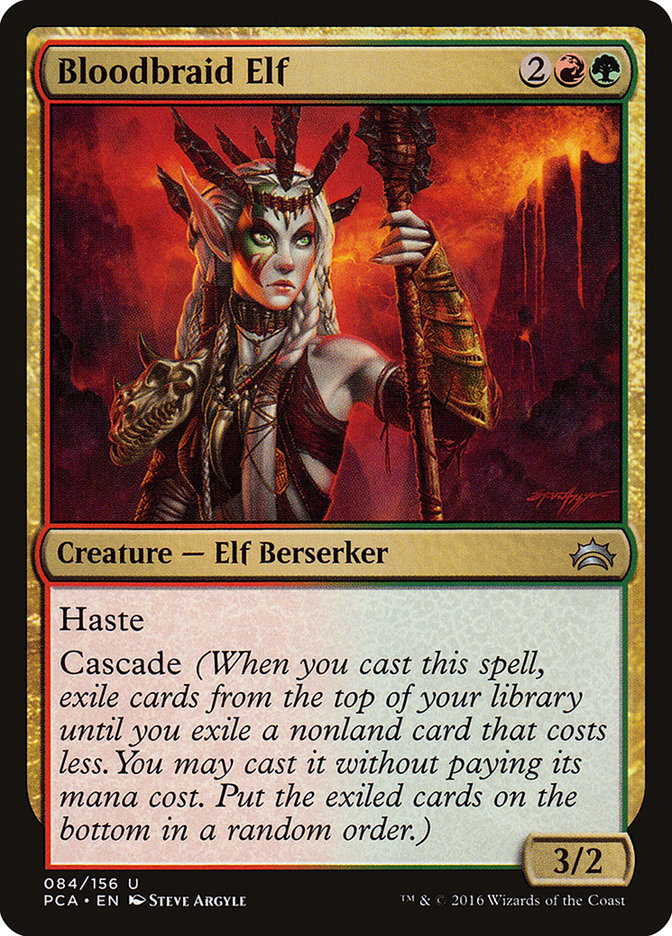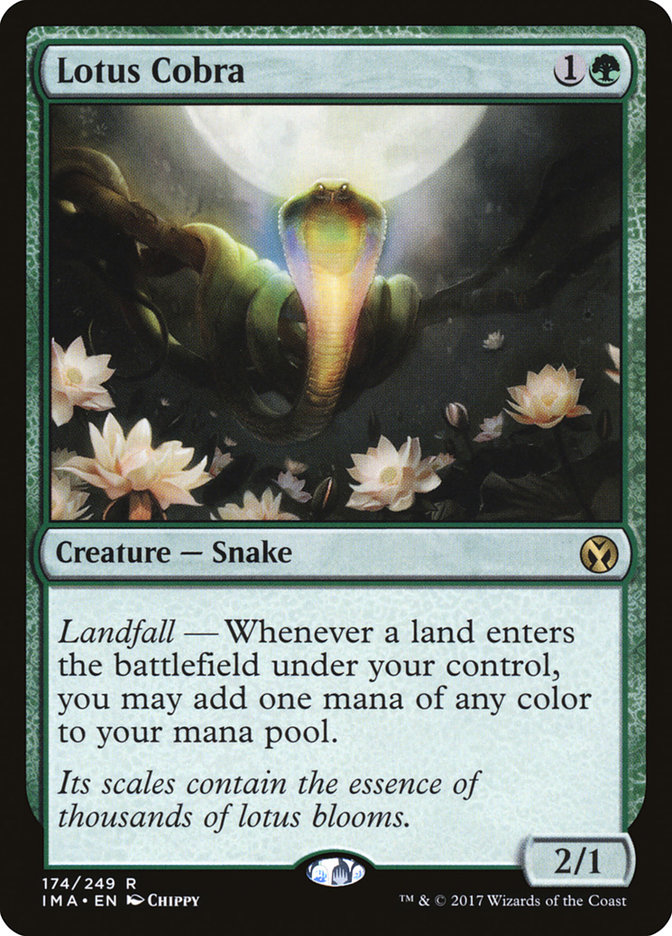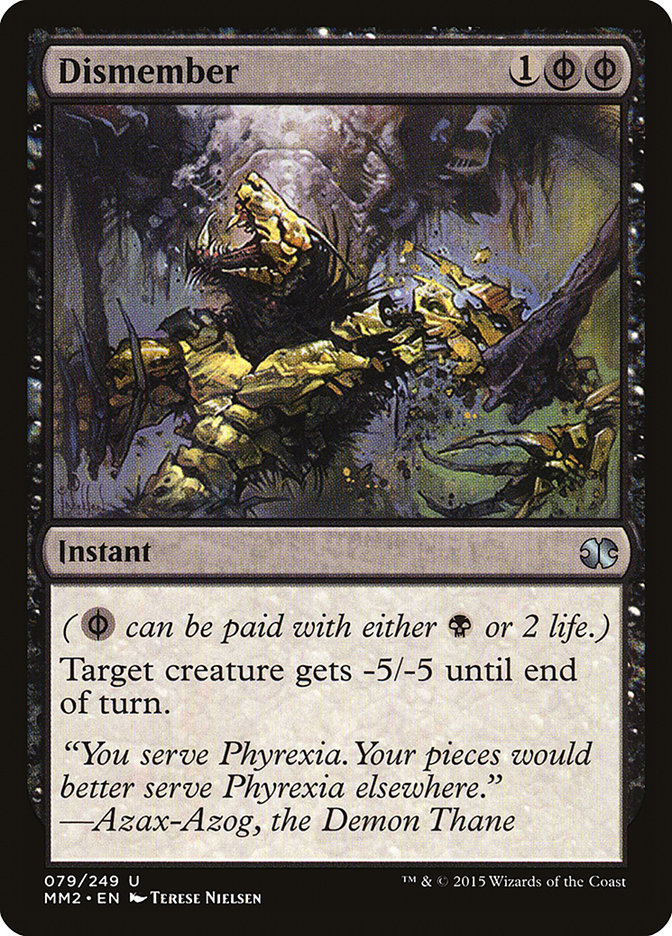Modern just went through its first major test on the highest level over the
last two weeks with a Pro Tour and a Grand Prix back to back. It was a
chance for the best players in the world to push the format to its limits
and see if the diversity we’ve seen for the last year could pass the test.
With two top 8s that were not only individually diverse, but diverse as a
whole, and replete with everything from non-interactive combo decks to
aggressive creature decks to disruption heavy midrange and control decks
and even a splash of prison in the form of Lantern Control, I’d say the
format passed with flying colors.
So, I had planned to write about the challenge of taking what happened over
the course of those tournaments, even beyond the top 8 lists, and put
together a more coherent picture of where the format stood going into
SCG Indy this weekend. I guess WotC had different plans.
We’re baaaaaaack.
Yes, Jace, the Mind Sculptor and Bloodbraid Elf are entering Modern. For
the Elf, it’s a second go after an initial ban that I personally felt was
unwarranted and more due to the fact that WotC was hesitant to ban the
recently printed and altogether overpowered Deathrite Shaman, which ended
up taking its own turn at the guillotine shortly thereafter. For Jace, one
of the most iconic cards in Magic’s history, Modern is completely new
territory.
After years of clamoring for some cards to come off the ban list and few of
them making inroads in the format (Golgari Grave-Troll being a notable
exception) we now get two cards that were particularly divisive among
players. Jace, the Mind Sculptor was banned in its Standard format and
Bloodbraid Elf could’ve reasonably been banned as well given how dominant
Jund was for a time. Both have seen significant play in Legacy, although a
decline in recent years suggests that the power level of larger formats is
catching up with the pair that are now nearly a decade old.
Are they set to dominate Modern and end this golden era of the format? Are
they simply going to give Jund and blue control decks another powerful tool
to compete against the rest of the format? Or will these iconic cards go
the way of Sword of the Meek and Bitterblossom and fall to the fringes of a
format that has long since passed them by?
If you give anything more than a brief, passing speculation at these
questions, then you’re not focusing on the right thing. Whether or not you
or I or anyone else thinks these unbannings are appropriate or healthy for
Modern in the long run is irrelevant. They are coming back and it’s our job
as players to figure out how they’ll affect a Modern metagame that is
overrun with different decks, meaning there is a huge number of variables
at play.
If these cards are going to be factors in Modern moving forward, then
there’s a huge advantage to figuring out how to best utilize them for the
first few tournaments in which they’re legal. Do you remember the first
Legacy Open after the release of Khans of Tarkir? Bob Huang mowed down the
field with a four Treasure Cruise U/R Delver list that barely changed
afterward and it looked like he was playing a different game. Everyone else
cautiously added a delve card or two to their decks while Bob recognized
the potential, built around the best one, and was justly rewarded with a
trophy.
Now Treasure Cruise and Dig Through Time were unknown quantities at the
time, so Jace and Bloodbraid aren’t going to fly under the radar like those
did, but it’s important to understand how to best build with these cards,
especially because we have years of new cards to mix with them. How do we
maximize two of the most powerful threats in Magic’s history? Here are
three things to keep in mind over the coming weeks.
Lightning Bolt Just Got A Lot Better
I’ve written a lot recently about the ascendancy of Fatal Push as the
premier removal spell in Modern. Lightning Bolt is still quite popular, but
a lot of that has to do with the prevalence of Burn, where Lightning Bolt
serves a much different role than it does in a deck like Jund or Jeskai
Control. However, we saw early Lightning Bolts sneak back into the format
as the rest of the metagame reacted to Fatal Push with cards like Mantis
Rider.
Jeskai Control is a major deck in Modern right now, as is Mardu Pyromancer
after spending what feels like an eternity as a top deck in the online
metagame. However, the balance still certainly favors Fatal Push, and if
you don’t believe me, take a look at which one Reid Duke decided to play
next to his beat up copies of Tarmogoyf, Inquisition of Kozilek, and
Liliana of the Veil.
But both Bloodbraid Elf and Jace, the Mind Sculptor favor the burn spell
over the black one, and the format will shift as a result. For Jace, the
reasoning is obvious. The ideal scenario with Jace, the Mind Sculptor is to
activate its zero ability and get an immediate Brainstorm worth of value or
its -1 and get ahead on the battlefield. Both of these scenarios leave the
planeswalker vulnerable to a Lightning Bolt, an exchange that is very poor
on mana for the Jace player. However, the +2 is not particularly valuable
so having the ability to constantly threaten the Lightning Bolt leaves Jace
players in a tricky spot.
If your opponent +2s, then you have some time to answer the planeswalker
directly or pressure it with creatures without losing much, if any, value.
In this same scenario, Fatal Push is worse than useless. Killing a small
creature isn’t going to do much when your opponent is Brainstorming every
turn, unless it’s a critical blocker, at which point Lightning Bolt is
likely the same or better.
For Bloodbraid Elf, the case for Lightning Bolt is more subtle. After all,
if you’re cascading into a removal spell you’re probably just aiming to
attrition your opponent out of the game, at which point the versatility of
Fatal Push becomes more important than the aggressive capability of
Lightning Bolt. However, Bloodbraid Elf significantly shifts how midrange
decks operate, which is much of why the card is so overpowered.
Most players focus on the card advantage aspect of cascade, because card
advantage is easy to understand. If your Bloodbraid Elf casts a free one
for one of any kind and then trades with a creature or removal spell you’re
up in cards, and if you keep doing that, eventually your opponent won’t
have anything left and winning the game will be academic.
But there’s another aspect to cascade that is as important as the card
advantage, if not moreso–the mana advantage. Not only do you draw a card,
you get to cast it for free. No matter what you hit, you’re getting way
more than a replacement level four mana card, and hitting a quality removal
spell so your 3/2 haste creature is also a Ravenous Chupacabra is a huge
tempo swing.
With this mana advantage and ensuing tempo swing, Bloodbraid Elf lets
midrange decks turn the corner more quickly than any other card in Magic’s
history. Instead of a removal spell followed by a four point attack from a
Tarmogoyf, it’s a seven point swing and your opponent has two creatures you
need to answer.
Most Modern decks can topdeck their way out of this scenario, so rather
than blame luck when they do, it’s important to limit their number of turns
to get back into the game, which Lightning Bolt is great at doing. Send
that three to six damage upstairs and the game is over much faster than
your opponent is expecting, and if your opponent makes poor value plays in
order to protect their life total, then the card advantage kicks in to
punish them as the game drags on.
Bloodbraid Elf midrange decks are fundamentally more aggressive than their
non-elven counterparts, and packing the Lightning Bolts is an important
part of unleashing that aggression. You’ll still want a diverse suite of
removal spells with Fatal Push, Abrupt Decay, Terminate, Kolaghan’s
Command, and Maelstrom Pulse all as options depending on the metagame, but
Lightning Bolt is the core piece.
Maximizing the Mana Advantage
Let’s consider the mana advantage aspect of cascade a little further. If
it’s indeed the key aspect of Bloodbraid Elf, then we should be doing what
we can to maximize it. As a result, there’s a bit of a Collected Company
phenomenon happening, incentivizing us to push our curve toward three mana
cards, so we get the highest density of powerful hits off cascade.
Like Collected Company decks, that could lead to an awkward situation where
the early part of our curve is answered and our hand is full of clunky
threes that get overrun. Bloodbraid Elf is a great catch-up card in this
scenario, again like Collected Company, but it’s something to be wary of.
That said, successful Collected Company decks tend to glut at three for a
reason, so we should take that lesson to heart here.
I’m excited to play with lots of Lilianas (especially the Last Hope for the
rebuys), Maelstrom Pulses, and Kolaghan’s Commands so I can have the most
powerful Bloodbraid Elves on the block. I’ll want plenty of one-drops to
not fall behind when you don’t cascade on turn 4, but limit the less
impactful ones like Noble Hierarch, even if the tempo boost on turn 1 is
alluring.
Balancing this tension, as Collected Company decks have done, is going to
be the most important part to building your Jund deck in the early weeks of
the format. Find the right balance and you’ll have a great deck. Move too
far in one direction and you’ll need Bloodbraid Elf to work overtime to
make up for your mistakes.
Jace, the Mind Sculptor Wants All the Disruption
The key to maximizing any planeswalker is building your deck to
consistently navigate to a position where you can land it on a safe
battlefield and untap. Jace, the Mind Sculptor, as powerful as it is, is
not an exception to this rule. In fact, it’s rather vulnerable at four mana
for three starting loyalty with a lackluster loyalty-adding ability. It
didn’t dominate Standard until Bloodbraid Elf, a card that is well-poised
to keep it in check, rotated out.
And in the early days of Caw-Blade’s reign in Standard, a Temur Lotus Cobra
deck was a suitable rival, since the U/W deck didn’t have a quality answer
to Lotus Cobra until Dismember was printed, allowing the Temur deck to get
far enough ahead on the battlefield that the Caw-Blade player couldn’t land
a Jace, the Mind Sculptor.
So while players may talk about every Modern game ending when someone plays
a Jace on turn 4, the reality is a lot trickier. You need to work to have
that happen, and most of that work comes during deckbuilding.
No one doubts the power of Jace, the Mind Sculptor to dominate a game once
it stays on the battlefield for a turn or two. Each Brainstorm, when
combined with a fetchland is a significant advantage that compounds
quickly. So knowing that power, it would be wise to use more deck space on
early disruption, relying more heavily on Jace to carry the long game. That
means picking color combinations with access to two quality one mana
removal spells, so Jeskai, Grixis, or Esper. Given the increased value of
Lightning Bolt I’d assume Esper is the worst of the three, and that aligns
with how the format currently stands anyway.
The next change is in how you account for control mirrors. A Jeskai deck
that’s built to operate at instant speed with Snapcaster Mage, Cryptic
Command, and Torrential Gearhulk would likely be a favorite against one
clogged with three or four four mana sorceries that will be hard to
resolve. As such I’m inclined to lean toward Grixis since it gives you
access to the discard spells necessary to force a Jace through. Typically
those cards are liabilities in a deck that wants to go long but the ability
to shuffle them away with a fetchland after a Brainstorm goes a long way
toward mitigating that problem. Discard spells offer yet another avenue of
cheap disruption against linear decks that will seek to punish you for
tapping out on turn 4.
I’d start here:
Creatures (4)
Planeswalkers (3)
Lands (27)
Spells (26)

This is a first pass so I’d expect it to be rough, but it illustrates the
design philosophy from above. Part of not falling behind so you can land
Jace on turn 4 or 5 is not missing land drops, so despite a lower curve I
went to a colossal 27 lands and offset the chance of flood with a bunch of
utility lands. Creeping Tar Pit is great at attacking Jace, and Field of
Ruin is the best answer to opposing creature-lands, as well as a necessity
against Tron, which is a deck that stands to match up well against
Bloodbraid Elf and Jace decks.
It’s possible I’ve gone overboard on disruption here and should find room
for some Serum Visions or Opts, but I’m okay leaning as much on Jace as
possible to start in order to figure out just how much weight he can carry
in Modern.
The one Tasigur may be out of place, especially because delve creatures
match-up poorly against Jace’s -1, but I think a creature threat that’s
good late game and can add some versatility to Kolaghan’s Command is worth
one slot.
There’s a lot to explore with the two newest additions to Modern, but it’s
important to remember that even the most powerful cards in the format need
to be placed in the proper context to succeed. Don’t be surprised if
jamming four Bloodbraid Elf or Jace, the Mind Sculptor into your deck fails
to make it immediately tier one. If you weren’t around for when these cards
were previous staples, then you’ll have more work to do than others, but
keep these principles in mind and work to maximize these cards and the
potential for greatness is there.







